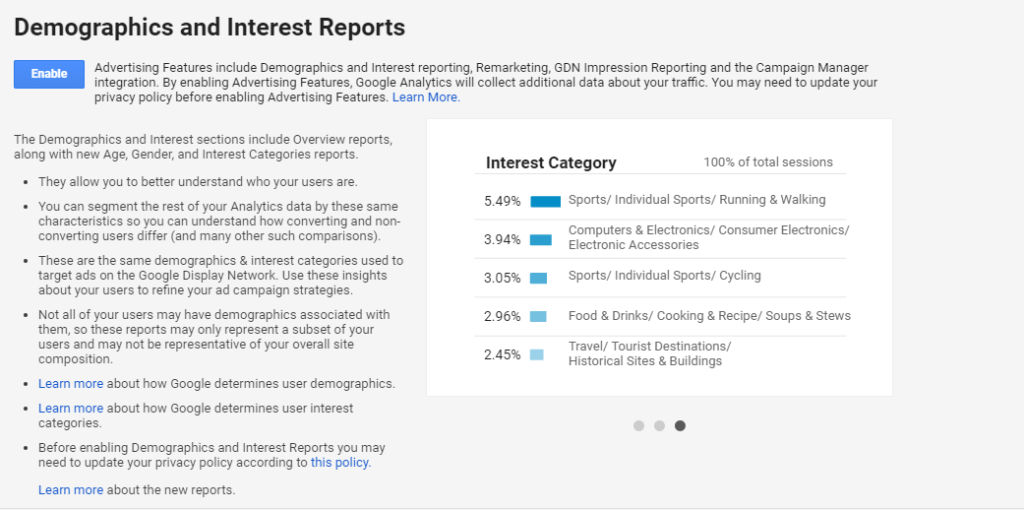Why It Is Important to Know Your Audience
Content marketing is aimed at creating valuable and relevant materials that will attract potential customers. So, to be successful, you need to understand what your target audience might be interested in. Then, you’ll be able to make your marketing strategy more efficient and reduce expenses.
Otherwise, writing content without readers in mind is a long shot, which may or may not bring you closer to your goal. By dedicating some time to exploring demographics, interests, and reactions of your audience, you’ll make it a whole lot easier to gain their attention and trust.
Ways to Learn About Your Audience
There are a lot of different ways to get to know your audience better. Try as many as you can to get the whole picture and then use it to develop an efficient content marketing strategy.
1. Use Google Analytics
Google Analytics is a powerful tool that can give you many insights about your audience. Reports are basically divided into nine sections: Overview with general statistics (page views, bounce rate, number of users, etc.), audience demographics, interests, geography, behavior, technology, mobile, custom, and user flow.
Technology reports will give insights into the devices and browsers that readers use. By better understanding your audience preferences, you may optimize the website accordingly. For example, adjust the content for mobile screens, etc. The Behavior and Users flow reports help improve user experience on your site, and in the Interests section, you’ll discover hobbies and personal interests of your readers.

Google Analytics also allows you to set up different goals in the Admin section, regarding audience engagement, and so on. This will help you track progress and adjust the strategy along the way.

2. Conduct Surveys
This is a great way to understand your audience better because it allows you the opportunity to ask questions directly. Create a short and sweet survey that won’t take long to fill out and provide an incentive in return, from a discount or promo code, to exclusive content on your site. To create an effective survey, follow a few simple rules:
- Keep your questions short and direct
- Put easier questions in the beginning of the survey
- Ask one question at a time
- Speak your respondent’s language
There are many dedicated services like SurveyMonkey, Typeform, or Customer Feedback Software by HubSpot. With their help, you can create a survey within a couple of minutes and start interviewing.
3. Review Your Successes
By analyzing your website content and campaigns that have proven to be successful, you’ll see what your readers are interested in the most. Check the posts with the highest number of views, comments, likes, and shares and try to analyze what exactly drew the audience. Then use your findings when creating new content.
Likewise, review the posts with lower engagement—weak points that led you to failure—and avoid them in the future.
4. Keep Your Eye on Competitors
One more step to knowing your audience is to look at one of your competitors. They may not exactly match, but there will be some similarities for sure.
On the one hand, you’ll see what tricks help rival companies attract and retain users that you can adopt too, and on the other, which audiences you haven’t covered yet, but your competitors have. Find more tips on how to analyze and target your competitors’ audience in our post.
5. Monitor Social Media
Social media is an amazing source to learn about your audience engagement, as it allows users to instantly give feedback. By analyzing their engagement on your social pages, you will be able to determine hot and low-interest topics and build your content strategy accordingly.
You can also run surveys or communicate with your readers directly, by responding to their comments and questions.
Furthermore, social media is a great way to know your audience’s interests and aspirations by exploring their personal profiles.
6. Experiment With Content
Even if some types of content tend to work well with your audience, it should never stop you from exploring other options. Different content types are beneficial for different types of information, for example, infographics perfectly represent complex data, while case studies help prospective clients assess the benefits of your company. Another reason to experiment is to diversify your site materials and present a fresh perspective for your audience.
Here are some examples of top-performing content marketing types:
- Blog posts
- Checklists
- Videos
- Interviews
- Infographics
- Case studies
- ebooks and PDFs
- White Papers
- Social media posts
7. Use Research Tools
Dedicated tools can help analyze your audience better and optimize your work. Some of the most popular platforms are SEMrush, Keyword Tool, Followerwonk, Google Analytics, etc.
While Google Analytics is a free tool and offers general insights, other programs can get you a more detailed picture for a fee. For example, SEMrush presents your and your competitors’ organic search domain overview and does backlink, keyword, and ranking research. Followerwonk analyzes Twitter data, makes bio search, and more. Keyword Tool helps to conduct keyword research and increase your ranking.
8. Create a Buyer Persona
Buyer persona is your average site visitor. It is a fictional character that you can create based on your audience and take into account when writing content.
What do you need to know about your target audience to create a buyer persona? Here are a few suggestions:
- Location, age, language, interests, etc.
- Problems and pain points
- Needs and goals
- The way you can help solve these issues
What to Do Next
Understanding your target audience can help adjust the strategy and tailor content more efficiently. Think of pain points and interests of your readers, analyze their engagement, and stay in close contact to keep up with the latest changes. This will give you ideas of not only topics to cover, but also the angle to present the information from and maybe even the development path for your blog.




